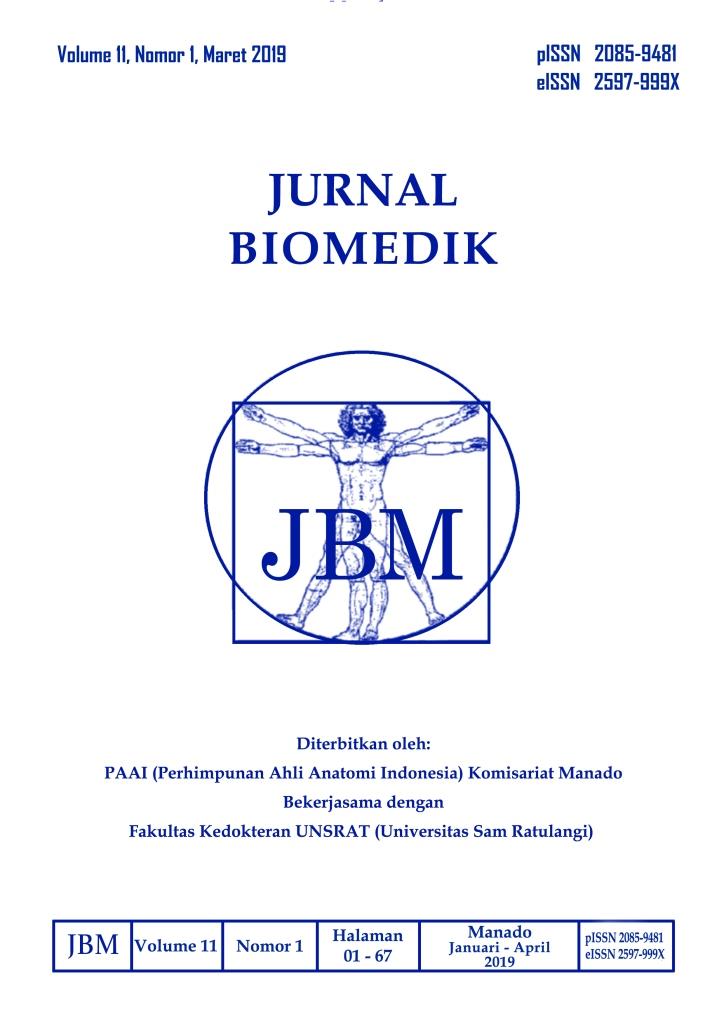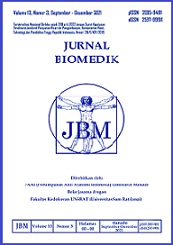Gambaran Mikrokopik Serebelum pada Hewan Coba Postmortem
DOI:
https://doi.org/10.35790/jbm.11.1.2019.23205Abstract
Abstract: After death, there will be cellular changes that cause definite signs of death. These changes could be used to determine the time of death. This study was aimed to determine the microscopic changes of the cerebellum during 1 hour to 24 hours postmortem. This was a descriptive study. Four domestic pigs of more than 90 kg were used as animal models. After being killed, we made slices in the pig heads to expose and observe cerebellar microscopic changes in several time intervals, as follows: 90 minutes, 2 hours, 3 hours, 4 hours, 5 hours, 6 hours, 7 hours, 8 hours, 9 hours, 10 hours, 11 hours, 12 hours, 13 hours, 14 hours, 15 hours, 16 hours, 17 hours, 18 hours, 19 hours, 20 hours, 21 hours, 22 hours, 23 hours, and 24 hours postmortem. The results showed that the cerebellum became progressively pale and softened at 8 hours postmortem. Congestion in all tissues occured at 2 hours postmortem, however 69.2% of the Purkinje cells still had normal nuclei. At 7 hours postmortem, Purkinje cells began to enlarge associated with karyorrhexis, and at 21 hours postmortem most of the cells shrank. Albeit, at 24 hours postmortem the cerebellar layers could still be identified and some Purkinje cells with normal morphology could be found. Conclusion: Microscopic changes could be identified at 2 hours postmortem in the form of congestion of the cerebellar layers. Purkinje cells underwent karyorrhexis at 7 hours postmortem and shrank at 21 hours postmortem.
Keywords: Purkinje cells, cerebellar layers, postmortem
Abstrak: Setelah kematian, terjadi perubahan pada sel-sel yang menimbulkan tanda-tanda pasti kematian. Perubahan-perubahan yang terjadi dapat membantu menentukan saat kematian dalam suatu kasus hukum. Penelitian ini bertujuan untuk mengetahui perubahan mikroskopik serebelum selama interval waktu 1 jam hingga 24 jam postmortem. Jenis penelitian ialah deskriptif. pada hewan coba babi dengan rerata berat lebih dari 90 kg. Setelah hewan coba dimatikan, dibuat irisan di bagian kepala untuk menampakkan serebelum dan mengamati perubahan mikroskopiknya pada rentang waktu 90 menit, 2 jam, 3 jam, 4 jam, 5 jam, 6 jam, 7 jam, 8 jam, 9 jam, 10 jam, 11 jam, 12 jam, 13 jam, 14 jam, 15 jam, 16 jam, 17 jam, 18 jam, 19 jam, 20 jam, 21 jam, 22 jam, 23 jam, dan 24 jam postmortem. Hasil penelitian mendapatkan serebelum tampak pucat dan melunak secara progresif pada 8 jam postmortem. Kongesti di semua jaringan mulai terjadi pada 2 jam postmortem dan ditemukan 69,2% sel Purkinje berinti yang masih normal. Sel Purkinje mulai membesar dan inti mengalami karioreksis pada 7 jam postmortem tetapi pada 21 jam postmortem sel-sel tersebut tampak menyusut. Meskipun demikian hingga 24 jam postmortem struktur lapisan serebelum masih dapat diidentifikasi dan sel Purkinje dengan morfologi normal masih ditemukan. Simpulan: Perubahan mikroskopik serebelum sudah dapat diidentifikasi pada 2 jam postmortem yaitu berupa kongesti lapisan serebelum. Sel Purkinje mengalami karioreksis pada 7 jam postmortem dan menyusut pada 21 jam postmortem.
Kata kunci: sel Purkinje, lapisan serebelum, postmortem
Downloads
Published
Issue
Section
License
Penyunting menerima sumbangan tulisan yang BELUM PERNAH diterbitkan dalam media lain. Naskah yang masuk dievaluasi dan disunting keseragaman format istilah dan cara penulisan sesuai dengan format penulisan yang terlampir dalam jurnal ini.
Segala isi dan permasalahan mengenai tulisan yang yang diterbitkan dalam jurnal menjadi tanggung jawab penuh dari penulis.







